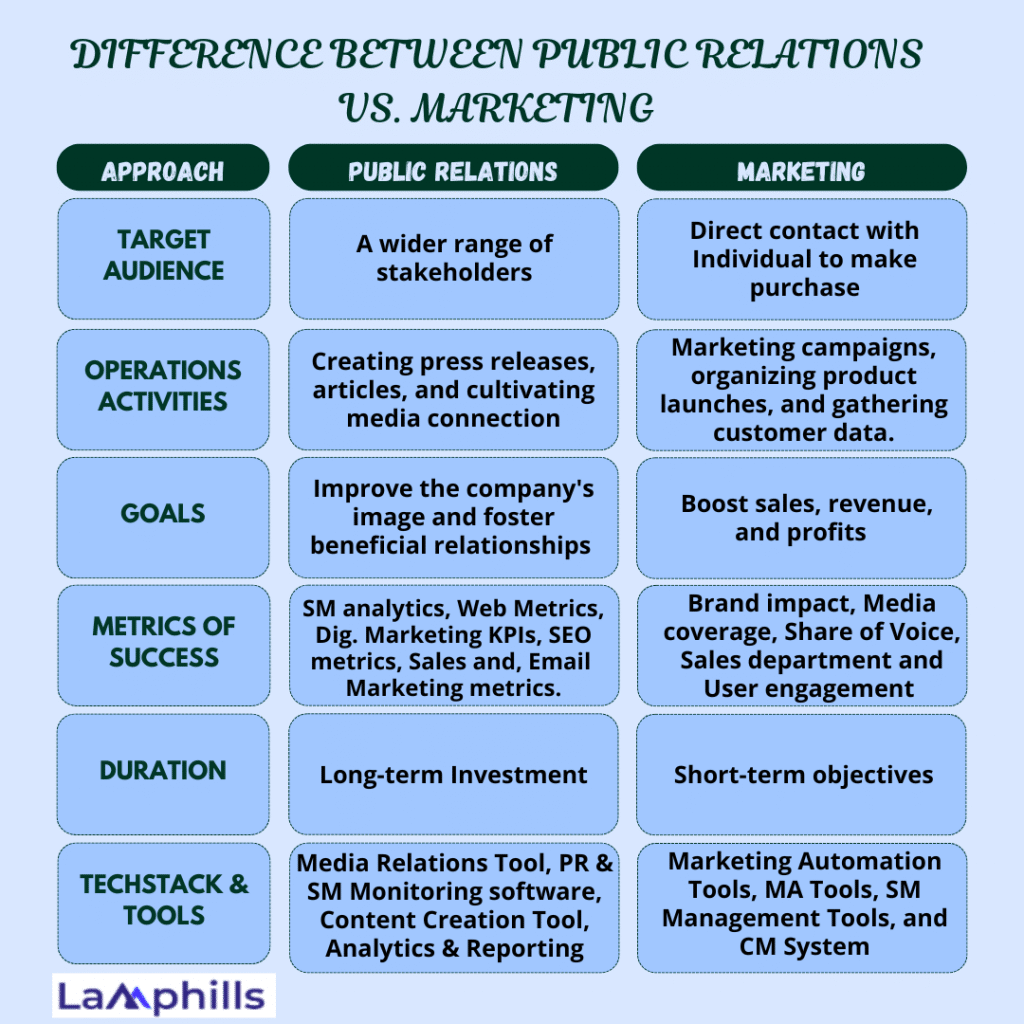If you’re managing a company or developing a brand, you’ve probably wondered about the best way to promote your brand: “Which is better Public relations vs. marketing?” There is no simple solution to this question because both are essential to developing and maintaining a strong brand. But knowing their distinct roles, advantages, and when to apply each can greatly impact your overall plan.
Although marketing and public relations (PR) are sometimes used interchangeably, they have different functions. PR is concerned with preserving a positive public image and fostering relationships, whereas marketing concentrates on advertising goods or services to increase sales. The difference has implications beyond education; it may influence how you handle customer relations, corporate expansion, and crisis management. In this article, I’ll cover all you need to know about Public Relations vs. Marketing. How they differ when to use each, and how I leverage them effectively in my daily activities. I’ll also be uncovering some new perspectives and groundbreaking ideas that will keep you ahead of the curve.
Key Takeaways
- Understanding the distinct roles of public relations (PR) and marketing is crucial for a comprehensive brand strategy. Recognizing these differences allows for better handling of customer relations, corporate growth, and crisis management.
- The key difference between PR and marketing lies in their objectives and target audiences. Marketing focuses on consumers who are potential buyers, aiming to meet financial goals through direct sales efforts. PR, however, targets a wider range of stakeholders and focuses on creating a favourable public perception and building long-term relationships.
- Success metrics for PR and marketing differ significantly. While marketing relies more on quantitative data, PR often involves qualitative assessments.
What is Public Relations?
Public relations is about managing a company’s reputation and building relationships with key stakeholders, including customers, employees, investors, and the media. Press releases, media appearances, and social media interaction are just a few of the instruments PR specialists employ to sway public opinion and uphold a favourable reputation.
The following are a few of the primary roles of PR:
- Managing one’s reputation.
- public relations.
- Events.
- Public relations branding.
Another critical function of PR is dealing with negative press. The PR unit has to mitigate any harm if the company is mentioned negatively in a story. This typically entails either interpreting the tale in a favourable light or apologizing on behalf of the business.
What is Marketing?
Marketing is the act of promoting and selling goods and services. It includes customer service, sales tactics, promotion, and market research. By delivering enticing messages and offers to specific consumers, marketing seeks to increase sales and revenue.
- Content marketing.
- Email marketing.
- Social media marketing.
- Influencer marketing.
The audience is made aware of a good or service that addresses a need they have through these many marketing channels. That audience gradually builds a relationship with the business and might even become a customer.
What is the Difference Between Public Relations vs. Marketing?

While PR concentrates on creating and preserving a positive image, marketing seeks to increase sales. Knowing the difference between the two approaches will help you prioritize them according to your short-term objectives.
#1. Target audience

Marketers’ primary focus is the consumer, or more specifically, the individual who will make the purchase. To meet the company’s financial objectives, it is essential to identify the appropriate target market, or those most likely to show interest in the product.
Public relations concentrates on a wider range of stakeholders, including consumers, the media, influencers, and other relevant parties. Depending on the demands of the business at the time, there may be instances where PR and marketing tactics overlap with the target demographic.
In both situations, creating personas and fictitious individuals that stand in for various customer types is typically quite helpful. It is necessary to conduct a detailed analysis of the target group to grasp their issues, behaviours, information-seeking locations and methods, and decision-making processes.
#2. Operational Activities
In general, marketing mostly entails addressing the market and its demands. Professionals in marketing and public relations typically allocate their time extremely differently. This covers ongoing market research in addition to lead management, budgeting, and planning. Marketers utilize data to inform their decisions, and as a result, they take activities in areas like promotion and advertising, which directly result in sales. Marketing experts spend their time developing marketing campaigns, organizing product launches, and gathering customer data.
Public relations (PR) encompasses all of an organization’s actions directed towards its surroundings, both externally and internally. To match business operations with stakeholder expectations, a company’s public relations efforts are essential. Public relations specialists are frequently seen creating press releases, submitting favourable articles about the business, and cultivating connections with the media.
Without public relations, no marketing campaign could be considered fully formed. Someone concerned about a well-crafted strategy that will be well-received must prioritize maintaining the brand’s image.
Related: How To Create a Winning Public Relations Contract (The Ultimate Guide)
#3. Goals
The marketing and PR divisions approach their work with quite different objectives in mind. While marketing concentrates on contacting clients and prospects and boosting sales. They work hard to meet the needs of their clients and can persuade potential buyers to buy a product by creating a desire in them. A marketing campaign’s primary objectives are to boost sales, revenue, and profits (as quickly as possible).
Public relations (PR) aims to improve the company’s image and foster beneficial relationships with its diverse stakeholders. They create a positive image and shape a positive view of the organization’s operations, not to create wants. Sales aren’t always immediately impacted by it. You shouldn’t anticipate outcomes right away. It will take time for them to arrive.
#4. Metrics of Success

The way that PR and marketing assess success is another important difference between the two fields. By contrast, marketing could consider whether a product achieved its sales targets or the return on investment from a previous campaign. Success in marketing and public relations is quantified. Furthermore, practically everything can be measured in digital marketing.
- Brand impact
- Media coverage
- Share of Voice (SOV)
- Sales department response time,
- Social media reach and
- User engagement (to streamline the process, use an Instagram reporting tool, for example).
In reality, PR measurements are merely a drop in the vast ocean of indicators available for marketing analysis. PR experts take into account whether or not they successfully generated favourable buzz for the business. In addition to the data mentioned above, a comprehensive marketing study should look at the following measures as well:
- Social media analytics
- Website metrics,
- Digital marketing KPIs (such as CTR, CPA, etc.)
- Content marketing and
- SEO metrics
- Sales and revenue metrics, and
- Email marketing metrics.
Marketing analytics are undoubtedly more comprehensive than PR managers, and marketers must conduct far more analysis. Marketing is more concerned with quantitative statistics than with qualitative data, in contrast to public relations.
#5. Duration
When it comes to marketing, the present is everything. You wish to perform better and reach your objectives more rapidly. Because of this, marketers typically have short-term objectives and don’t plan too far ahead. They can then determine what to do after considering the current results.
PR, on the other hand, calls for patience. PR can be thought of as a long-term investment that eventually pays off, in contrast to marketing, which strives for rapid sales.
#6. Tech Stack
For PR and marketing campaigns to be successful, multiple tools are needed.
Your tech stack for PR will include the following components:
- Media Relations Tool: You may locate and get in touch with journalists, bloggers, and other influencers by using the extensive media directories and contact databases offered by websites like Cision and Muck Rack.
- Public relations software: Sites such as PR Newswire offer the resources required for tracking media attention, distributing press releases, maintaining relationships, crafting story pitches, and more.
- Social media monitoring software: Mention and Brand24 are excellent resources for keeping tabs on internet mentions, reviews, and comments related to your company.
- Content Creation Platform Tools: Hootsuite Amplify, Canva, and Adobe Spark offer all the tools required to produce excellent visuals for your narrative.
- Analytics and Reporting: Pitchbox and Meltwatwer are two platforms that offer comprehensive reporting tools that let you gauge the effectiveness of your campaigns.
In the meantime, marketers will usually require a separate set of resources:
- Marketing Automation Tools: HubSpot and Marketo are two platforms that offer the data and infrastructure required to track consumer activity and create customized campaigns.
- Marketing Analytics Tools: You can track conversions and maximize the return on investment from your campaigns by utilizing platforms such as Google Analytics and Mixpanel, which offer insights into customer behaviour.
- Social Media Management Tools: Hootsuite and Sprout Social are excellent systems for managing social media accounts on many networks.
- Content Management System: To create and maintain a website, you’ll need a CMS, such as Squarespace or WordPress.
A Well-Detailed PR Campaign Planning Template Available Below
Which is better Public Relations vs. Marketing?

Every option has advantages and disadvantages, and how well they work will depend on your objectives and situation.
- Complementary Advantages: Marketing and PR complement each other well. While marketing generates immediate sales and sells products, public relations (PR) excels at managing reputations and establishing long-term connections.
- Disparities by Industry: Each industry may have a different ratio of PR to marketing. PR plays a critical role in upholding credibility and confidence in industries such as banking and healthcare. When it comes to consumer goods, marketing frequently takes precedence over sales.
- Industry-Specific Objectives: Depending on the industry, PR vs marketing importance can change dramatically. In highly regulated sectors such as pharmaceuticals, public relations plays a critical role in upholding compliance and confidence. Sales-driven marketing is frequently more important with fast-moving consumer items.
- Encouraging Quick Outcomes: Marketing usually takes the lead when the objective is to promote immediate sales and growth. Results from sales tactics, targeted advertising, and promotional initiatives can come in quickly.
You can decide how best to use your resources and create a plan that takes into consideration the benefits of both Public Relations vs. marketing by knowing the distinct benefits and uses of each. The secret is to see marketing and public relations as complementary instruments that, when combined, may provide a potent and comprehensive strategy for accomplishing your company’s goals rather than as competing forces.
Is PR just Marketing?
No, PR is not just marketing. Although there are some goals and strategies that PR and marketing have in common, they are two separate disciplines with different objectives, approaches, and results. Gaining an understanding of these distinctions is essential to use both to accomplish your company goals. These are separate fields with particular objectives, approaches, and results. While marketing seeks to increase sales and engage consumers, public relations concentrates on reputation management, connection building, and crisis communication.
Nonetheless, there are connections between and benefits from both fields of study. Through the integration of PR and marketing strategies, enterprises may formulate a strong and all-encompassing approach that fosters expansion, establishes credibility, and guarantees continued success.
When Can You Use PR or Marketing?
When used appropriately, both disciplines can be effective instruments with specific uses.
- Promoting new goods or services
- Handling crises.
- Boost Recognition of Your Brand
- Enhances brand reputation
- Communicate to the stakeholders
- Increase revenue and sales
Once you recognize the distinct advantages of every field and their mutual enhancement, you may build a more efficient and all-encompassing communication plan.
Conclusion
In summary, the backdrop of your business position and your particular aims will determine whether you should utilize marketing or public relations. Marketing vs. public relations are essentially two sides of the same coin. PR stresses long-term strategic positioning, whereas marketing concentrates on quick, tactical results. Knowing when and how to use these effective tools may make all the difference in a variety of situations, from launching new goods to managing crises, building brand reputation to boosting sales. To reach your overall business objectives, it is important to recognize the specific strengths of each field and to use them in a coordinated way. To create a long-lasting brand legacy, how can your company properly integrate and balance PR and marketing?
Related Articles
- Branded Content Marketing: The Powerful Strategy Big Brands Don’t Want You to Know
- 15+ Public Relations Tools That Work: A Personal Guide to Enhancing Your PR Strategy
- Customer Marketing: 8 Killer Customer Marketing Strategies for Building Your Brand






